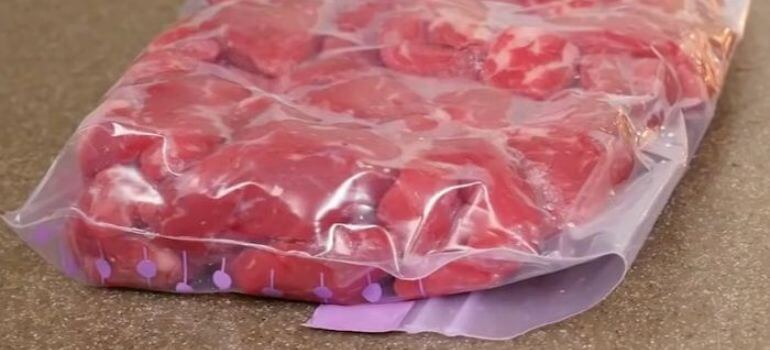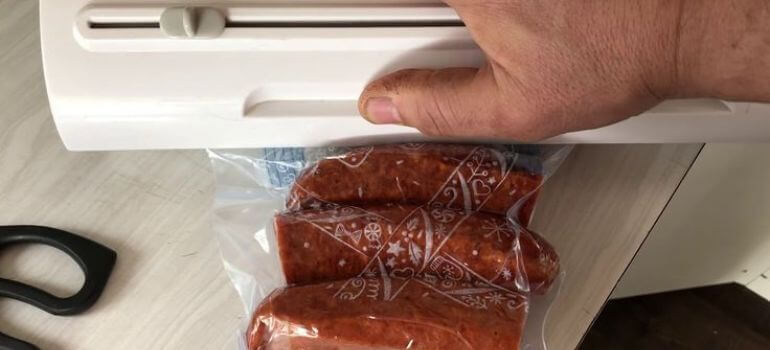In the modern kitchen, the battle for the best food storage method is ongoing. While traditional Ziploc bags have long been a staple, the rise of vacuum sealing technology introduces a compelling alternative. In this article, we’ll explore the pros and cons of vacuum sealing versus using Ziploc bags, helping you make an informed decision about the most suitable method for your needs.
Introduction
In a world where convenience meets preservation, understanding the differences between vacuum sealing and Ziploc bags is crucial. These methods play a vital role in keeping our food fresh and flavorful, but the question remains: which one is superior?
The Basics of Vacuum Sealing
Let’s start by unraveling the mystery behind vacuum sealing. What exactly is it, and how does it work? We’ll dive into the fundamental principles and explore the myriad benefits that come with this innovative food preservation method.
Ziploc Bags: A Familiar Choice
On the flip side, we have the familiar Ziploc bags—an old favorite for storing everything from sandwiches to marinated meats. We’ll examine their features, uses, and the pros and cons that come with this household staple.
Preservation Power: Vacuum Sealing
One of the primary considerations when choosing a food storage method is its ability to preserve. We’ll explore how vacuum sealing excels in extending the shelf life of food, protecting against freezer burn, and maintaining optimal freshness and flavor.
Environmental Considerations
In a world increasingly focused on sustainability, the environmental impact of our choices cannot be overstated. When it comes to food storage, the decisions we make, such as choosing between vacuum sealing and Ziploc bags, can have lasting effects on our planet.
Eco-friendliness of Vacuum Sealing

Reducing Food Waste:
One of the key environmental advantages of vacuum sealing lies in its ability to extend the shelf life of food. By minimizing exposure to air, vacuum-sealed items stay fresher for longer, reducing the likelihood of premature spoilage and subsequent disposal. This directly contributes to the broader effort to combat food waste.
Minimal Packaging Waste:
Vacuum sealing often involves the use of reusable bags or containers, cutting down on the need for disposable packaging. This not only reduces the amount of plastic entering landfills but also lessens the overall demand for single-use materials.
Energy Efficiency:
While the energy consumption of vacuum sealers is a consideration, their efficiency in preserving food can lead to energy savings in the long run. The reduced need for frequent grocery trips and the ability to buy in bulk contribute to fewer transportation-related emissions.
The Impact of Plastic Usage in Ziploc Bags
Single-Use Plastics:
Ziploc bags, on the other hand, are typically designed for single-use. This contributes significantly to the global plastic pollution crisis. The production, distribution, and disposal of single-use plastics generate substantial carbon footprints and harm ecosystems.
Recycling Challenges:
While some Ziploc bags are recyclable, the reality is that recycling infrastructure and accessibility vary widely. In many cases, these bags end up in regular household waste, further exacerbating environmental concerns.
Long-Term Consequences:
The persistent nature of plastic in the environment means that even if properly disposed of, Ziploc bags can take hundreds of years to break down. This prolonged existence poses threats to wildlife and ecosystems, impacting the delicate balance of our planet.
Choosing the Environmentally Responsible Path
Consideration for Alternatives:
When evaluating the environmental impact of your food storage choices, it’s crucial to consider the long-term consequences. Vacuum sealing, with its emphasis on reusability and reduced waste, aligns more closely with sustainable practices.
Mindful Consumption:
Ultimately, making environmentally conscious choices extends beyond the method of food storage. It involves being mindful of consumption patterns, opting for eco-friendly materials, and actively participating in efforts to reduce the overall environmental footprint.
In conclusion, the environmental considerations associated with vacuum sealing and Ziploc bags highlight the need for conscientious decision-making. While both methods serve their purposes, choosing an option that aligns with sustainable practices can contribute to a healthier planet for current and future generations.
Cost-effectiveness
Is the initial investment in a vacuum sealer justified in the long run? We’ll break down the costs and compare the financial aspects of vacuum sealing with the more budget-friendly Ziploc bags.
Convenience Factor
For those seeking convenience in the kitchen, we’ll assess the ease of use with Ziploc bags and the time-saving benefits that come with vacuum sealing.
Suitability for Different Foods
When it comes to choosing between vacuum sealing and Ziploc bags for food storage, one size does not fit all. Each method has its strengths and weaknesses, making them better suited for certain types of foods and situations. Let’s explore the diverse landscape of food storage and identify when to opt for the airtight embrace of vacuum sealing and when to rely on the versatile simplicity of Ziploc bags.
Ideal Uses for Vacuum Sealing
Long-term Storage of Raw Meats:
Vacuum sealing excels in preserving the freshness of raw meats over extended periods. By removing the air, the risk of freezer burn is minimized, ensuring your meats maintain their flavor and quality for months.
Bulk Purchases and Meal Prep:
For those who enjoy buying in bulk or engaging in meal prepping, vacuum sealing provides an effective solution. Portioning out meals and vacuum sealing them not only extends their shelf life but also maintains their original taste and texture.
Marinating for Flavorful Results:
When marinating meats or vegetables, vacuum sealing allows for a more thorough infusion of flavors. The airtight environment ensures that the marinade penetrates the food evenly, resulting in a more delicious and flavorful outcome.
Preservation of Sensitive Foods:
Delicate items such as berries or soft fruits can be prone to crushing and spoilage. Vacuum sealing offers a gentle yet effective way to protect these sensitive foods, maintaining their structural integrity and extending their freshness.
When Ziploc Bags Take the Lead
Convenient Snack Storage:
Ziploc bags are the go-to choice for convenient and portable snack storage. Whether it’s a handful of nuts, a sliced apple, or your favorite chips, the ease of use and accessibility make Ziploc bags perfect for on-the-go snacking.
Everyday Fridge Storage:
For items that you’ll use within a relatively short timeframe, like leftovers or daily-use ingredients, Ziploc bags provide a simple and convenient storage solution. Their accessibility makes them a staple in many kitchens for everyday use.
Freezing Soups and Sauces:
While liquids can pose a challenge for vacuum sealing, Ziploc bags handle them with ease. Soups, sauces, and broths can be securely stored in Ziploc bags, allowing for efficient use of freezer space without the risk of spills.
Quick Marinating for Busy Days:
If you’re short on time and need to marinate in a hurry, Ziploc bags offer a quick and effective solution. Toss your ingredients and marinade into the bag, squeeze out excess air, and you’re ready to go.
Balancing Act: Choosing Based on Needs
Consideration for Food Types:
When selecting between vacuum sealing and Ziploc bags, consider the types of food you regularly store. A combination of both methods may offer the flexibility needed to address various culinary needs.
Practicality in the Kitchen:
Evaluate the practical aspects of your food storage routine. For long-term preservation and marinating, lean towards vacuum sealing. For everyday convenience and quick storage, keep Ziploc bags within easy reach.
In essence, the suitability of vacuum sealing or Ziploc bags for different foods boils down to understanding the unique characteristics of each method. By aligning your choice with the specific needs of your food items, you can ensure optimal freshness and convenience in your culinary adventures.
Health and Safety
Ensuring the safety of stored food is paramount, and the methods we choose for food storage play a crucial role in maintaining its integrity. Let’s delve into the health and safety considerations associated with both vacuum sealing and Ziploc bags to help you make informed decisions about the well-being of your stored provisions.
Food Safety Aspects of Vacuum Sealing
Reduced Oxygen, Reduced Spoilage:
One of the primary benefits of vacuum sealing is its ability to create an oxygen-free environment. This significantly reduces the risk of bacterial growth and spoilage, contributing to enhanced food safety. Vacuum-sealed items are less susceptible to contamination, especially in the absence of air.
Extended Shelf Life without Compromising Quality:
By minimizing exposure to air and external contaminants, vacuum sealing helps extend the shelf life of food without compromising its quality. This makes it a reliable method for preserving perishable items, ensuring they remain safe for consumption over an extended period.
Ideal for Sous Vide Cooking:
Vacuum-sealed bags are commonly used in sous vide cooking, a method that involves cooking food at precise, low temperatures. The airtight seal ensures that the food is cooked evenly and retains its natural flavors, contributing to a safe and enjoyable culinary experience.
Potential Risks Associated with Ziploc Bags
Limited Airtight Seal:
While Ziploc bags provide a convenient and accessible means of food storage, they may not offer the same level of airtight sealing as vacuum-sealed bags. This could potentially lead to a shorter shelf life for certain items and an increased risk of spoilage.
Susceptibility to Freezer Burn:
In the freezer, Ziploc bags may not provide as effective a barrier against freezer burn as vacuum-sealed bags do. Freezer burn can compromise the texture and flavor of food, although it doesn’t necessarily pose health risks.
Plastic Leaching Concerns:
Some studies suggest that prolonged exposure to plastic, as in the case of Ziploc bags, may lead to the leaching of chemicals into the stored food. While regulatory bodies have deemed these levels generally safe, individuals with specific health concerns may opt for alternative storage methods.
Best Practices for Ensuring Health and Safety
Follow Manufacturer Guidelines:
Whether using vacuum sealers or Ziploc bags, it’s crucial to adhere to the manufacturer’s guidelines. This includes proper sealing techniques, recommended storage durations, and any specific precautions to ensure the safety of the stored food.
Regular Inspection and Rotation:
Regardless of the storage method, regularly inspecting and rotating your stored items helps prevent the unintentional consumption of expired or compromised food. This practice is especially important in minimizing health risks associated with long-term storage.
Labeling and Dating:
Clearly labeling and dating your stored items can be a simple yet effective strategy. This ensures that you’re aware of the age of the stored food, allowing you to prioritize items nearing the end of their recommended shelf life.
In conclusion, both vacuum sealing and Ziploc bags can be safe and effective methods for food storage when used appropriately. By understanding the advantages and potential risks associated with each method, you can make informed decisions that prioritize the health and safety of the food you and your loved ones consume.
Burstiness in the Kitchen: Vacuum Sealing
Beyond preservation, vacuum sealing offers creative uses in the kitchen. We’ll explore tips and tricks for maximizing the benefits of vacuum sealing beyond its primary purpose.
Flexibility of Ziploc Bags
Conversely, Ziploc bags bring a level of versatility that might surprise you. We’ll discuss their adaptability in various situations and offer practical tips for using them effectively.
Choosing the Right Method for You
Decision time. We’ll provide a comprehensive guide on factors to consider when choosing between vacuum sealing and Ziploc bags, allowing you to tailor your choice to your individual needs and preferences.
Consumer Reviews and Experiences
What better way to make an informed decision than by learning from others? We’ll include real-life testimonials on vacuum sealing and gather user feedback on the experiences of using Ziploc bags.
Troubleshooting Common Issues
No method is without its challenges. We’ll address common problems and provide solutions for both vacuum sealing and Ziploc bags, ensuring you’re equipped to tackle any issues that may arise.
Conclusion
As we wrap up our exploration of vacuum sealing versus Ziploc bags, we’ll recap the key points and leave you with encouragement to choose the method that aligns best with your lifestyle and culinary preferences.
FAQs
While vacuum sealing is excellent for freezer storage, it’s also ideal for preserving food in the refrigerator and pantry.
Yes, Ziploc bags can be reused if properly cleaned, and many are indeed dishwasher-safe.
When done correctly, vacuum sealing is a safe method of food preservation. However, proper hygiene and handling are crucial to avoid contamination. When done correctly, vacuum sealing is a safe method of food preservation. However, proper hygiene and handling are crucial to avoid contamination.
Ziploc bags are versatile and can be used for a variety of foods, including snacks, sandwiches, and marinated items.
Common issues with vacuum sealers include sealing problems and air leakage. Refer to the user manual for troubleshooting tips or contact the manufacturer for assistance.



